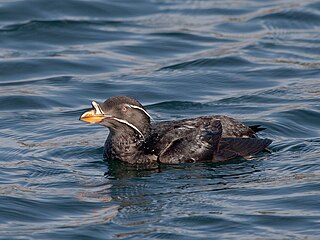 W
WAn auk or alcid is a bird of the family Alcidae in the order Charadriiformes. The alcid family includes the murres, guillemots, auklets, puffins, and murrelets. The word auk is derived from Icelandic álka, from Old Norse alka (“auk”), from Proto-Germanic *alkǭ.
 W
WAethia is a genus of four small (85–300g) auklets endemic to the North Pacific Ocean, Bering Sea and Sea of Okhotsk and among some of North America's most abundant seabirds. The relationships between the four true auklets remains unclear. Auklets are threatened by invasive species such as Arctic foxes and Norway rats because of their high degree of coloniality and crevice-nesting.
 W
WAlca is a genus of charadriiform bird that contains a single extant species, the razorbill (Alca torda). Many fossil species are known, the oldest dating back to the Miocene. The genus appears to have always been restricted to the North Atlantic.
 W
WCerorhinca is a genus of auk containing the rhinoceros auklet and several fossil species.
 W
WThis article can be expanded by translating the content from a French GA article.
 W
WPuffins are any of three species of small alcids (auks) in the bird genus Fratercula. These are pelagic seabirds that feed primarily by diving in the water. They breed in large colonies on coastal cliffs or offshore islands, nesting in crevices among rocks or in burrows in the soil. Two species, the tufted puffin and horned puffin, are found in the North Pacific Ocean, while the Atlantic puffin is found in the North Atlantic Ocean.
 W
WThe tufted puffin, also known as crested puffin, is a relatively abundant medium-sized pelagic seabird in the auk family (Alcidae) found throughout the North Pacific Ocean. It is one of three species of puffin that make up the genus Fratercula and is easily recognizable by its thick red bill and yellow tufts.